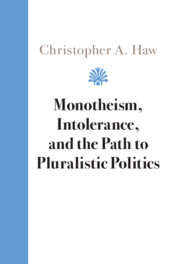Book contents
- Monotheism, Intolerance, and the Path to Pluralistic Politics
- Monotheism, Intolerance, and the Path to Pluralistic Politics
- Copyright page
- Contents
- Preface
- Abbreviations
- Introduction
- 1 Pluralism’s Requisite Intolerance
- 2 Girard’s Mimetic Theory and Monotheism’s Ambivalent Effects
- 3 Monotheism and the Monopoly on Violence
- 4 Containing Violence and Two Entirely Different Kinds of Religion
- 5 Polytheism and the Victim in Ancient Egypt
- 6 A Political Theology of the Mosaic Distinction
- 7 Jesus Christ and Intolerance
- 8 Conclusion
- Bibliography
- Index
8 - Conclusion
How to Be Intolerant
Published online by Cambridge University Press: 04 June 2021
- Monotheism, Intolerance, and the Path to Pluralistic Politics
- Monotheism, Intolerance, and the Path to Pluralistic Politics
- Copyright page
- Contents
- Preface
- Abbreviations
- Introduction
- 1 Pluralism’s Requisite Intolerance
- 2 Girard’s Mimetic Theory and Monotheism’s Ambivalent Effects
- 3 Monotheism and the Monopoly on Violence
- 4 Containing Violence and Two Entirely Different Kinds of Religion
- 5 Polytheism and the Victim in Ancient Egypt
- 6 A Political Theology of the Mosaic Distinction
- 7 Jesus Christ and Intolerance
- 8 Conclusion
- Bibliography
- Index
Summary
The Conclusion ties the themes of the book together to emphasize monotheism not as an "identity forged negatively against the other," nor as an escape from this othering. Rather, through the apophatic intolerance explored in all chapters, monotheism is conceived as othering-in-reverse, as a revelation of our blindness to scapegoating the other, highlighting our need not for mere inclusivity but agonistic pluralism.
Keywords
- Type
- Chapter
- Information
- Monotheism, Intolerance, and the Path to Pluralistic Politics , pp. 246 - 251Publisher: Cambridge University PressPrint publication year: 2021

